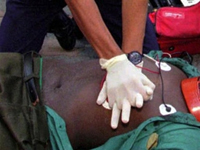First priority given to chest compressions
For years, some 911 dispatchers have been telling callers how to do chest compressions in an emergency. After reviewing hundreds of cases where compressions saved lives, the association is urging everyone who feels uncertain about their CPR skills to do just chest compressions.

Cardiopulmonary resuscitation (CPR) is an emergency medical procedure for a victim of cardiac arrest or, in some circumstances, respiratory arrest. CPR is performed in hospitals or in the community by laypersons or by emergency response professionals.
CPR has for 50 years consisted of the combination of artificial blood circulation with artificial respiration (also known as mouth-to-mouth),that is chest compressions and lung ventilation. However, in March 2008 the American Heart Association, in an historic reversal, endorsed the effectiveness of chest compressions alone--without artificial respiration--for adult victims who collapse suddenly in cardiac arrest. CPR is generally continued, usually in the presence of advanced life support, until the patient regains a heart beat (called "return of spontaneous circulation" or "ROSC") or is declared dead.
CPR is unlikely to restart the heart, but rather its purpose is to maintain a flow of oxygenated blood to the brain and the heart, thereby delaying tissue death and extending the brief window of opportunity for a successful resuscitation without permanent brain damage. Defibrillation and advanced life support are usually needed to restart the heart.
Mouth-to-mouth breathing is still recommended for infants, children and drowning and overdose victims."
Subscribe to Pravda.Ru Telegram channel, Facebook, RSS!




